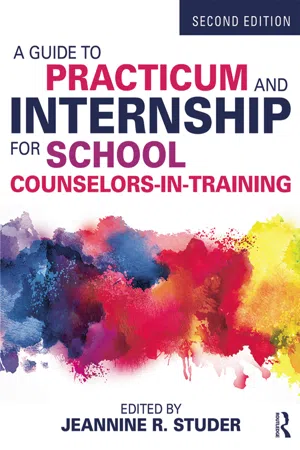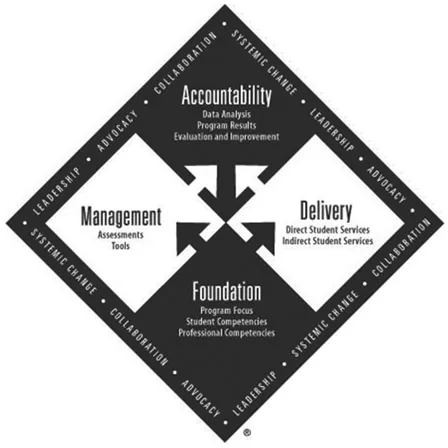
A Guide to Practicum and Internship for School Counselors-in-Training
- 278 pages
- English
- ePUB (mobile friendly)
- Available on iOS & Android
A Guide to Practicum and Internship for School Counselors-in-Training
About this book
A Guide to Practicum and Internship for School Counselors-in-Training, 2nd ed, covers all aspects of the practicum and internship experience, from the initial contact with supervisors to detailed descriptions of students' different roles. Readers will gain both an awareness of the school culture and the understanding needed to develop an individualized philosophy of school counseling. Specific topics covered include popular counseling theories used by school counselors, strategies for working with special populations of students, understanding the school counselor's role in utilizing the 2012 National Model of the American School Counselor Association (ASCA) including the inherent elements and themes, putting the ASCA ethical standards into practice, and administration of day-to-day tasks. Each chapter contains activities, case studies, worksheets, and images to facilitate understanding, and all material presented is consistent with both the accreditation standards of the Council for the Accreditation of Counseling and Related Educational Programs (CACREP) and the school counselor standards identified by the ASCA.
Frequently asked questions
- Essential is ideal for learners and professionals who enjoy exploring a wide range of subjects. Access the Essential Library with 800,000+ trusted titles and best-sellers across business, personal growth, and the humanities. Includes unlimited reading time and Standard Read Aloud voice.
- Complete: Perfect for advanced learners and researchers needing full, unrestricted access. Unlock 1.4M+ books across hundreds of subjects, including academic and specialized titles. The Complete Plan also includes advanced features like Premium Read Aloud and Research Assistant.
Please note we cannot support devices running on iOS 13 and Android 7 or earlier. Learn more about using the app.
Information
The American School Counselor Association (ASCA) National Model as a Structure for Understanding the Role of the Professional School Counselor
6
The ASCA National Model as a Supervisory Guide
CACREP Standard
Counseling, Prevention, and Intervention
C. Knowledge
- 2. Knows how to design, implement, manage, and evaluate programs to enhance the academic, career, and personal/social (now renamed social/emotional) development of students.
Foundations
A. Knowledge
- review the ASCA National Model
- introduce the ASCA National Model as a template for supervision
- discuss time percentage recommendations as a tool to guide supervisory activities.
Introduction
A Summary of the Development of the Asca National Standards (Now Asca Mindsets and Behaviors for Student Success)
A Review of a CDSC Program
- ensures that all students have equal access to a rigorous curriculum that is delivered systematically,
- identifies the knowledge and skills all students are to acquire upon graduation from high school,
- emphasizes data collection and analysis to make informed decisions.


Table of contents
- Cover
- Title
- Copyright
- Dedication
- Contents
- Preface
- Acknowledgements
- About the Editor
- About the Contributors
- SECTION I The Practicum and Internship Journey
- SECTION II The American School Counselor Association (ASCA) National Model as a Structure for Understanding the Role of the Professional School Counselor
- SECTION III Diversity and Developmental Issues Among School-Aged Youth: Guidelines for the School Counselor-in-Training
- SECTION IV Completing the Clinical Experiences
- Index